

| |||
Registration & Licencing |
Rules of the Road |
||
Speed Limit |
Safety |
||
Procedures at Locks |
Mooring & Anchoring |
||
Navigation Information |
Sound Signals |
||
Facilities |
Connecting Waterways |
||
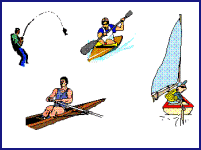
Just like its predecessors, the Envirnment Agency (EA), as the navigation authority for the River Thames, has to balance the needs of the numerous activities that are attracted to the River including boating enthusiasts, canoeists, dinghy sailors and yachtsmen, fishermen, holidaymakers in hired craft, naturalists, rowers and oarsmen, swimmers, sub-aqua divers and walkers. As can be expected with so many interests to look after, rules and regulations are required.
The first rule you need to know is that you cannot have a boat on the non-tidal river without it first being registered with the EA . This applies to all types of pleasure craft, including motor cruisers, sailing cruisers, narrow boats, open vessels such as canoes or rowing boats and houseboats. An annual fee is payable upon registration and covers the period 1 January to 31 December. A licence plate is then issued which must be displayed on the vessel.
This is not new: registration fees were introduced in 1887 when the fee was 2s 6d (equal to 12.5 pence) per annum for a private pleasure boat. In addition, fees were payable at each lock.
Today the registration fee depends upon the size of the boat which is calculated by its area. Our boat which is 10.4m long and 3.8m wide has a chargeable area of 39 square metres and for which we will have to pay £411.06 for 2005 which equates to £10.54 per square metre. The rate per square metre depends upon its Class. Our boat is Class ‘N’ which is a privately owned pleasure boat not being used for let or hire. If you don’t display your Licence plate you are likely to be stopped by a lockkeeper or by an inspector on one of the EA launches that patrol up and down the River.
Electrically propelled launches are charged at 75% of the normal annual registration fees.
Registration documents for the Thames can be obtained (by post only) from:
Environment Agency
Kings Meadow House
Kings Meadow Road
Reading
RG1 8DQ
Telephone : 0118 953 5650
Boats visiting the Thames also need to be registered and there are three types of registration available.
Option 1 - one day certificate (max 6 per year);
Option 2 - 15 consecutive day certificate (max 2 per year);
Option 3 - 31 consecutive day certificate (max 1 per year);
It is now possible for boaters visiting the Thames to 'mix and match' their visitor registration certificates. You can now choose a combination of the three different registration certificates per year which will allow visitors to travel along the Thames for a total of 67 days by purchasing up to six one-day registrations, two 15-day registrations and one 31-day registration.
Visiting boats entering the Thames from another waterway or launching into the River from one of the many slipways, may obtain registration documents at any of the following locks during published hours of duty.
St.John's, 01367 252309 | Pinkhill, 01865 881452 | Eynsham, 01865 881324 |
Kings, 01865 553403 | Godstow, 01865 554784 | Osney, 01865 247050 |
Iffley, 01865 777277 | Abingdon, 01235 523044 | Culham, 01235 522061 |
Mapledurham, 0118 941 7776 | Caversham, 0118 957 5764 | Sonning, 0118 9693992 |
Shiplake, 0118 940 3350 | Boveney, 01753 862764 | Romney, 01753 860296 |
Bell Weir, 01784 432333 | Penton Hook, 01784 452657 | Chertsey, 01932 562208 |
Shepperton, 01932 221840 | Sunbury, 01932 782089 | Molesey, 020 8979 4482 |
Teddington, 020 8940 8723 |
Any boat that is fully registered with the EA for use on the River Thames can have a FREE two week visitors licence for the River Medway and for the EA's Anglian Region's navigations.
From 1 January 2000, owners of private boats based on the Thames can apply for a joint registration and licence (called a 'Gold Licence'), which will allow the boat to be used on the Thames as well as on other waterways under the jurisdiction of the EA or British Waterways in England and Wales. In 2004 some 129 Thames based boats took advantage of this scheme whilst 1077 boats with Gold Licences visited the Thames from other regions.
Special application forms for a Gold Licence are only available from:
British Waterways
Willow Grange
Church Road
Watford
WD1 3QA
Telephone : 01923 201120
In 2004, 14057 craft were registered to use the Thames (9049 motor boats, 352 hire boats, 57 passenger steamers, 99 houseboats and 4500 unpowered craft). In addition, there were 2483 boats using the river but were exempt from registration (approved Youth Association, Racing Club and Crown craft) with another 5277 visiting boats excluding the 2917 boats that were issued with 'Open Event' plates. It's no wonder we have rules and regulations! It is interesting to note that in 1900, some 541 launches, 162 houseboats and 11284 rowing boats were licenced with the Thames Conservancy to use the Thames. Quite a contrast!

All boats must now have a valid Boat Safety Certificate before they can be registered.
Although all the locks on the Thames are manned, the good news is that no additional lock tolls or fees are charged by the EA (until 2000 there was a fee payable to use Richmond Lock which is under the control of the PLA but this is now also free). However, this has not always been the case. Until 1976 tolls had to be paid at every lock passed which was in addition to the annual registration fee.
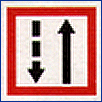
Unlike the roads in the UK, you drive on the right hand side of the River and pass oncoming boats port (left) side to port side. When overtaking other boats you do so on its port side towards the middle of the river. The biggest problem is remembering to change back again when you leave the boat and get into your car!
Near bridges and bends, a boat going upstream must, if necessary, give way to boats coming downstream and motor boats should always give way to sailing boats, rowing boats and larger passenger vessels which may have difficulty manoeuvring.
It is useful to remember that oarsmen never face the direction in which they are going, that sailing boats need to ‘find’ their wind , that the helmsman on a hired holiday cruiser has probably only had about 15 - 20 minutes tuition from the hire company before setting off and that the person steering a small open boat may have hired it for an hour or so and it is likely that they have never been in a boat before. It is therefore essential to always keep a good lookout and be prepared to slow down or stop.
Until fairly recently there wasn't a speed limit on the non-tidal River but there was a general rule that a boat should not exceed a brisk walking pace which is roughly 4 to 5 miles per hour.
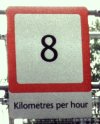

However, there is now a statutory speed limit of 8 kilometres per hour over the bed of the river. It was generally accepted and recognised that a speed limit was in all our interests as excessive wash, created by speeding boats, caused untold damage to the riverbank, wildlife and moored up boats (wash can still be a problem even with a speed limit). But it was controversial for two reasons: the units of measurement selected and the way in which it was to be applied.
On the roads in the UK we do not use the metric system: all distances are measured in miles and speeds given in miles per hour. As far as boats are concerned we, like a number of other countries, measure speed in knots (nautical miles per hour). In their wisdom however, the authorities on the Thames have decided to use kilometres per hour, a unit to which many of us cannot relate. So , for those like us:-
8 Kilometres per hour = 5 miles per hour = 4.3 knots
In applying the speed limit the authorities have chosen to measure the speed ‘over the bed of the river’ rather than ‘through the water’. This gives rise to two problems. It doesn’t take into account the current, which can be considerable, and it doesn’t recognise that logs (speed indicators) fitted to boats measure speed through the water. There is no mechanism on a boat for measuring its speed over the ground unless it has GPS fitted.
This to a certain extent has been recognised by the EA who have installed, in the following locations, red triangles on black and white poles set on the side of the riverbank at distances such that it should take one minute to travel between them at the speed limit.
Port Meadow, Oxford |
Upstream of Medley Boat Station |
Upstream of Day's Lock |
|
Dreadnought Reach, Reading |
Downstream of entrance to Thames & Kennet Marina |
Towpath at Cockmarsh |
Downstream of Bourne End Railway Bridge |
Shepperton |
Desborough Channel |
Kingston Towpath |
Downstream of Raven's Ait |

If it takes less than a minute you are speeding! This helps to correlate your log, but beware, River Inspectors on the EA launches have Radar guns.
As a matter of interest and in contrast, on the tidal Thames above Wandsworth Bridge there is a speed limit of 8 knots through the water. Below Wandsworth Bridge there is no limit but 10 knots is regarded as a safe speed.
Any activity on the river poses a greater risk when there are strong currents and high river levels. Warning signs displayed at the locks should always be heeded.
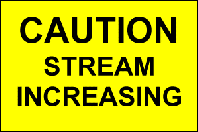
When the yellow CAUTION STREAM INCREASING / DECREASING warning boards are displayed, all unpowered craft are advised to moor up until the stream abates. When INCREASING stream is indicated all vessels are advised to seek a safe mooring. If a DECREASING stream is indicated, powered craft may proceed with caution.
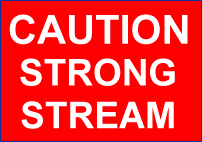
When the red CAUTION STRONG STREAM warning boards are displayed, all craft are advised not to navigate until the stream abates. In strong stream conditions it is advisable to keep off the River.
Boating on the Thames is fun and relaxing but it can be dangerous so never take risks on the River. Anyone with any experience of using the River will tell you never to underestimate its power: accidents can and do happen. It is therefore advisable for children and non-swimmers to wear lifejackets especially in locks and for children to be kept in sight at all times.
Details of the state of the stream, and other navigational information, can be obtained by telephoning the following number (Flood Line) at any time and listening to the recorded message.
When prompted PRESS 1 for current information.
When prompted again use the 'Quick Dial Number'
011131 (For strong stream, stream cautions & river flows)
011132 (For River works in progress)
011133 (For events on the River)

When waiting for a lock it is usual practice to form an orderly queue at the lay-by. Queue jumping is very much frowned upon; it arouses ill feeling and can cause confusion and delay in entering the lock.

It is also a requirement that you moor on the lay-by as near to the lock as possible so that others can moor astern of you. When the lock is full any remaining boats at the lay-by should move forward. If the lock gates are closed you should never hoot your horn to attract the lock keeper; this is very bad form. Instructions given by lock keepers must be followed. Once you are in the lock and moored up you have to turn off your engine. The most important thing to remember is that the boat will be going up or down so you must adjust your mooring lines accordingly!
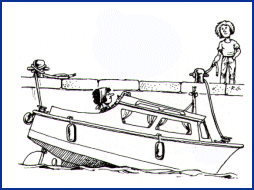
There is a long and proud tradition that lock keepers on the River Thames have never accepted tips. However, on a hot busy summer day a can of beer and a ‘thank you’ will not go amiss.
With the exception of Teddington Lock, which is manned 24 hours a day, lock keepers on the Thames are usually on duty during the following hours:-
January to March |
09.15 - 16.00 |
(If Easter falls in March, the opening hours over the holiday are 09.00 - 17.30) |
|
April |
09.00 - 17.30 |
May |
09.00 - 18.30 |
June to August |
09.00 - 19.00 |
September |
09.00 - 18.00 |
October |
09.00 - 17.00 |
November and December |
09.15 - 16.00 |
Locks are closed for lunch between 13.00 and 14.00 every day except in the summer, when 'Summer Assistants' may be on duty in some of the busier locks.
If you arrive at a lock after the lock-keeper has gone off duty, it is possible to operate the gates and sluices yourself. But, below Godstow where the locks are mechanically operated, you won't always have the luxury of electricity that the lock-keeper has. Only those locks that have power available to the public - see below - have the benifit of electricity. On all the other locks the winding gear has to be used . It can be rather tiring work but they say the exercise is good for you! Instructions for the public use of locks outside normal hours are given on the control pedestal.
The locks that have power available to the public are Molesey, Sunbury, Shepperton, Chertsey, Penton Hook, Bell Weir, Old Windsor, Romney, Boulters, Hambleden and Sonning. At these locks the power will be available from 0700hrs to 2200hrs during British Summer Time and from 0600hrs to 2100hrs during the winter months.
When you work the locks yourself you have to leave the lock empty with both gates closed.
Whenever possible Lock Maintenance and repair is carried out during the winter months in order to keep disruption to a minimum as lock closures are usually required. The EA announce in the Autumn a list of planned closures.
For a full list of planned lock closures for 2004 - 2005, Click Here
Boats have the right to anchor in the non-tidal River for up to 24 hours in any one place but it must not cause an obstruction to other users. As far as mooring to the bank is concerned this is more problematic. Whilst you may land on or embark from the towpath, there is no absolute right to moor as in a many places it is in private ownership.


The EA has about 20 public mooring sites along the river which are free but the maximum stay is 24 hours. There are of course other mooring sites which are either owned privately or by the local Council but in most of these places you will have to pay a small fee. Now and again you will find private moorings which are free such as the Meadow at Pangbourne, but these fill up fairly quickly. In the summer months it is advisable to have found your mooring spot by about 4 o’clock. Most good maps and books of the Thames have moorings marked. See also River Thames - Moorings. At most mooring sites you need your own mooring pins which are an essential piece of equipment on boats cruising up and down the River.
It is good practice to approach a mooring with your boat facing upstream into the current in order to maintain steerage at slow speeds. It is not advisable to approach the bank quickly and rely on reverse throttle to stop the boat: the golden rule is to manoevre slowly so that if things don't go quite as planned, which is not uncommon, damage will not arise. When leaving a mooring it is usually easier to manoevre the stern of the boat out first and then reverse out into the River.
Even on the non-tidal Thames, water levels can fluctuate considerably, especially overnight. It is therefore important to ensure that there is at least a few inches of water below the keel to avoid going aground. Similarly, mooring lines should not be too tight.
When mooring, have regard to other boaters. Don't moor in the middle of a space where there is room for more than one boat - move to one end so that others can also moor. Also be prepared to lend a hand to other boats coming in to moor especially if the wind is blowing them off the mooring. At busy times when mooring space is limited, be prepared to invite other similar vessels to raft up against you but DO NOT raft against another boat without first asking permission to do so from the owner. When rafting up make sure you have sufficient fenders in position and agree arrangements for walking across each others boat.
For added security at night, lower your anchor or mudweight.
The EA endeavour to maintain a minimum dredged depth on the non-tidal River. It is not a constant depth: it varies depending on where you are. Above Cricklade, there is no statutory right of navigation on the Thames. From Cricklade to Lechlade, navigation is only possible at times for the smallest of pleasure boats. Below Lechlade the fairway (navigable channel) is normally available for boats of the following sizes:-
Fairway |
Length |
Beam |
Draught |
Air Draught |
|---|---|---|---|---|
Teddington - Staines Bridge |
60.0m |
7.0m |
2.0m |
5.5m |
Staines Bridge - Windsor Bridge |
54.0m |
7.0m |
1.7m |
4.3m |
Windsor Bridge - Reading Bridge |
37.0m |
5.0m |
1.3m |
3.8m |
Reading Bridge - Folly Bridge |
33.5m |
5.0m |
1.2m |
3.7m |
Folly Bridge - Lechlade |
30.5m |
4.0m |
0.9m |
2.2m |

This sign is sometimes used by the EA where the depth is restricted.

Where there is any doubt as to which side of an island to pass or where there is a side channel, the correct channel to be used is usually well sign-posted.
Any obstructions in the fairway will also marked. Four types of markers are used - red can, green triangle, red sphere and 2 black spheres.




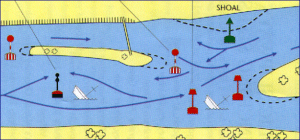
When travelling upstream you should pass a red can bouy with the bouy on your port (left) hand side and a green triangle bouy should be on your starboard (right) hand side.
Bouys are passed on the opposite side when going downstream. You can pass either side of a bouy with a red or black sphere.
The following sound signals are used by power driven vessels to indicate their intended actions:
Signal |
Meaning |
|---|---|
|
I am altering my course to STARBOARD |
|
I am altering my course to PORT |
|
My engines are going ASTERN |
|
Your intentions are not clear |
|
I am turning round with my bow swinging to STARBOARD |
|
I am turning round with my bow swinging to PORT |
means a short blast of about 1 second duration
For details of the facilities that are available for the boater, please Click Here
A number of other inland waterways can be entered from the Thames.

The River Way and Godalming Navigation is one of the earliest waterways. It was constructed to Guildford in c.1650 and to Godalming in c.1760 and was built with wide beam locks to take horsedrawn barge traffic from London . It may be entered at Weybridge but all visiting boats must be registered with the National Trust who are the navigation authority.
The River Kennet, which links the Thames to the Kennet and Avon Navigation (which goes to Bristol), can be accessed at Reading about half a mile below Caversham Lock. From its entrance on the Thames, to just below the High Bridge in Reading (upstream of Blake’s Lock), the EA are the responsible authority. Thereafter responsibility passes to British Waterways from which a licence is required.
The Oxford Canal can be accessed either through the Sheepwash Channel, just above Osney bridge, or through the Duke's Cut just above King's Lock. It gives access to the Midlands and the rest of the inland waterway system. It can take boats up to 2.08m (6'10'') wide.
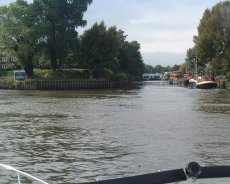
The Grand Union Canal can be entered from the tidal Thames at Brentford for about 2 to 2½ hours either side of high tide which is 1 hour later than high water at London Bridge. It provides access to the network of navigations extending to many locations throughout England and Wales. It can also be accessed at Limehouse Basin, below Tower Bridge, via the Regent Canal for 3 hours either side of high water. Both the Oxford and Grand Union Canals are under the jurisdiction of British Waterways.
For those contemplating a trip to Brentford or Limehouse to join the canal system, the notes in the 'River Thames - Tidal Navigation' page may be helpful. To view this page Click Here.
To return to The River Thames page Click Here
Copyright © The Harts